
Fig. 2.
Heatmap of soybean rhizosphere microbial genera significantly influenced by the growth stage (hash) and cover crops (stars) based on analysis of variance of log2(1 + x)-transformed sequence counts and clustered based on complete-linkage hierarchical clustering of Euclidean distances. Colored bars at the right top of the graph present the growth stage and cover crop treatments for each sample (A, bacterial genera; B, fungal genera) without considering cover crop treatment.
Cover crop legacies may promote beneficial changes in cash crop rhizosphere microbiota. Read the article by Chuntao Yin, Shannon L. Osborne, and R. Michael Lehman to learn more: https://doi.org/10.1094/PBIOMES-09-24-0086-R
02.12.2025 17:05 — 👍 1 🔁 1 💬 1 📌 0

“Characterization of Immunity-Inducing Rhizobacteria Highlights Diversity in Plant–Microbe Interactions” by Mack Loranger in the Yoshioka Lab is the Editor’s Pick in @phytobiomesjournal.bsky.social! Congratulations! 🧪🌱 #PlantScience #SoilScience apsjournals.apsnet.org/doi/10.1094/...
21.11.2025 16:56 — 👍 2 🔁 2 💬 1 📌 0

Fig. 5.
Composition of the root-associated fungal endophytic community of potato plants in samples grown in three different growing conditions: GER soil representing Germany, NL soil representing the Netherlands, and in vitro conditions. The relative abundances (%) are calculated for major fungal endophytic families present in the 11 potato cultivars (n = 3). Taxa are shown at the nearest classified level when family-level classification was unavailable.
Understanding the roles of endophytes in sustainable agriculture is a key focus of research. Jyotsna Nepal et al. investigated how 11 potato cultivars and 3 different growing conditions influence the diversity of microbial endophytes in potato roots: https://doi.org/10.1094/PBIOMES-08-24-0083-R
24.11.2025 17:06 — 👍 1 🔁 1 💬 1 📌 0

Fig. 1.
Schematic representation of the experimental design used to assess the impact of host plant species change or virus infection.
New research from Celia de Moya-Ruiz et al. underlines shifts in the #aphid microbiome, which could provide insights for further investigation of microbial resource-based solutions to control aphid pests and associated viral diseases in agriculture: https://doi.org/10.1094/PBIOMES-03-25-0017-R
14.11.2025 20:54 — 👍 1 🔁 2 💬 1 📌 0

Fig. 2.
Presence and absence of bacterial genes that influence plant hormone production or are known virulence factors in pathogenic Agrobacterium fabrum. Bacterial isolates are arranged on the vertical axis and genes on the horizontal axis. The legend shows whether a given gene is involved in plant hormone production or virulence.
Nicholas R. LeBlanc et al. characterized a novel endophytic #Agrobacterium sp. El2ro-1b from strawberry by generating and analyzing a high-quality genome assembly and testing the effects of the endophyte on plant growth: https://doi.org/10.1094/PBIOMES-01-25-0003-SC
06.11.2025 21:07 — 👍 1 🔁 1 💬 1 📌 0

Fig. 1.
Overview diagram of key themes and unknowns about endohyphal bacteria within the phytobiome, based on studies covered within this review. The metabolite exchanges and outcomes are representative of observed possibilities across diverse organisms and are not necessarily all true for any given single endohyphal symbiosis.
Dallas Moses and Morgan Carter compiled studies of endohyphal bacteria (EHB) from across diverse plant-associated microbes to provide a primer for EHB studies, considered through a phytobiomes lens, and comment on the directions of this emerging field: https://doi.org/10.1094/PBIOMES-12-24-0117-MRVW
29.10.2025 19:52 — 👍 3 🔁 1 💬 1 📌 0

Fig. 9.
Comparison of the pathogenicity of strains Z6, 2CM2G-5, TB1, and SW1 with that of an uninoculated control plant (CK).
Just Published: “Omics-Based Insights into Microbial Community Changes and Pathogen Identification in Strawberries Under Continuous Cropping,” by Chi Zhang et al.: https://doi.org/10.1094/PBIOMES-04-25-0027-R
24.10.2025 20:52 — 👍 2 🔁 1 💬 1 📌 0

Fig. 1.
Diversity of leaf symbiotic structures.
Léa Ninzatti, Marie-Françoise Jardinaud, and Aurélien Carlier review current knowledge of hereditary leaf symbiosis in tropical plants and explore hypotheses regarding mechanisms that enable these highly specific interactions: https://doi.org/10.1094/PBIOMES-11-24-0111-RVW
21.10.2025 16:55 — 👍 12 🔁 10 💬 0 📌 1

On this #WorldFoodDay, we celebrate the efforts of those who nourish our communities, protect our planet, and shape a better future through better food for all. Explore resources to learn more about food security and sustainability. #FAO80
https://bit.ly/4nqN3x7
16.10.2025 14:14 — 👍 4 🔁 7 💬 0 📌 0

Fig. 1.
Scheme of samples taken and parameters analyzed 56 days after planting apple genotypes M.26, EMR.2, G.202, and G.935 (rootstocks) and Malus spectabilis MAL0130 and M. sargentii MAL0739 (wild-type accessions) in soils from six different apple replant disease (ARD)-affected sites: HG, Heidgraben; HO, Holm; EH, Ellerhoop; PI, Pillnitz; RU, Ruthe; ME, Meckenheim. The soils were either untreated (ARD) or γ-irradiated (γARD).
Editor’s Pick: Findings from Kristin Hauschild et al. highlight that apple replant disease (ARD) tolerance in apple genotypes is linked to the soil microbiome and other soil properties, indicating the need for an integrated approach to management: https://doi.org/10.1094/PBIOMES-08-24-0082-R
14.10.2025 16:52 — 👍 0 🔁 0 💬 0 📌 0

Fig. 4.
Phylogenetic tree based on the alignment of partial 16S rRNA gene sequences from the 235 bacterial isolates that were collected from lettuce leaf samples at 38 or 67 days after planting (dap). Clades are colored according to taxon membership, down to the genus level, as per alignment with RDP type strains. An open circle next to the name of an isolate indicates that the isolate came from a 67-dap leaf sample. A black dot indicates that the isolate tested as a high producer of indole-3-acetic acid.
Editor’s Pick: “Bacterial Auxin Production in the Phyllosphere,” by Lorena I. Rangel et al. Read the article in Volume 9, Number 3 of Phytobiomes Journal: https://doi.org/10.1094/PBIOMES-02-25-0010-R
07.10.2025 17:08 — 👍 1 🔁 1 💬 1 📌 0

Fig. 1.
Here, we visualize how the impact of iterative microbiome passaging may differ with time.
Editor’s Pick: Terrence H. Bell et al. believe that there is no single “best” approach to iterative microbiome passaging but that experimental design choices can have substantial impacts on outcomes. Learn more: https://doi.org/10.1094/PBIOMES-11-24-0113-P
30.09.2025 18:50 — 👍 6 🔁 5 💬 1 📌 0
Mingming Yang et al. identified the seasonal and long-term population dynamics of root-associated bacterial communities over 8 years in monocropped wheat grown in adjacent dryland and irrigated plots in the low-precipitation region of Washington State: https://doi.org/10.1094/PBIOMES-02-24-0028-R
17.09.2025 20:15 — 👍 0 🔁 0 💬 0 📌 0
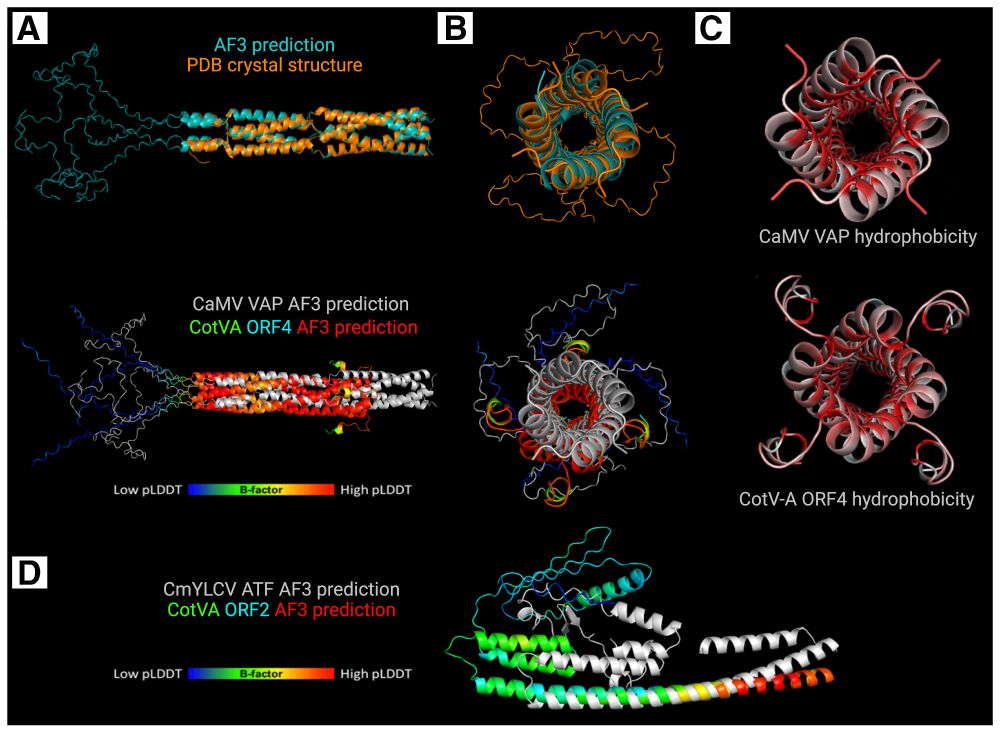
Predicted structural comparisons of cotton virus A (CotVA) open reading frames (ORFs) 2 and 4. A, Top: comparison of AlphaFold 3 (AF3) prediction (turquoise) over the Protein Data Bank crystal structure (3K4T, orange) of the cauliflower mosaic virus (CaMV) virion-associated protein (VAP). Bottom: structural alignment of the AF3 prediction of the CaMV VAP (white) with the AF3 prediction of CotVA ORF4 (colored). B, Same as A but seen from the bottom. C, Comparison of hydrophobicity of CaMV VAP (top), and the predicted hydrophobicity of CotVA ORF4 (bottom). D, Structural alignment of AF3 prediction of Cestrum yellow leaf curling virus (CmYLCV) aphid transmission factor (ATF) (white) to CotVA ORF2 (colored). Confidence in the predictions is measured in the B-factor field (temperature factor) colored from low confidence (cold colors) to high confidence (warm colors).
While investigating cotton leafroll dwarf virus in Mississippi,
Michael West-Ortiz et al. identified a novel virus, cotton virus A (CotVA), in Gossypium plants. Learn more: doi.org/10.1094/PBIO...
19.05.2025 19:34 — 👍 3 🔁 0 💬 0 📌 0
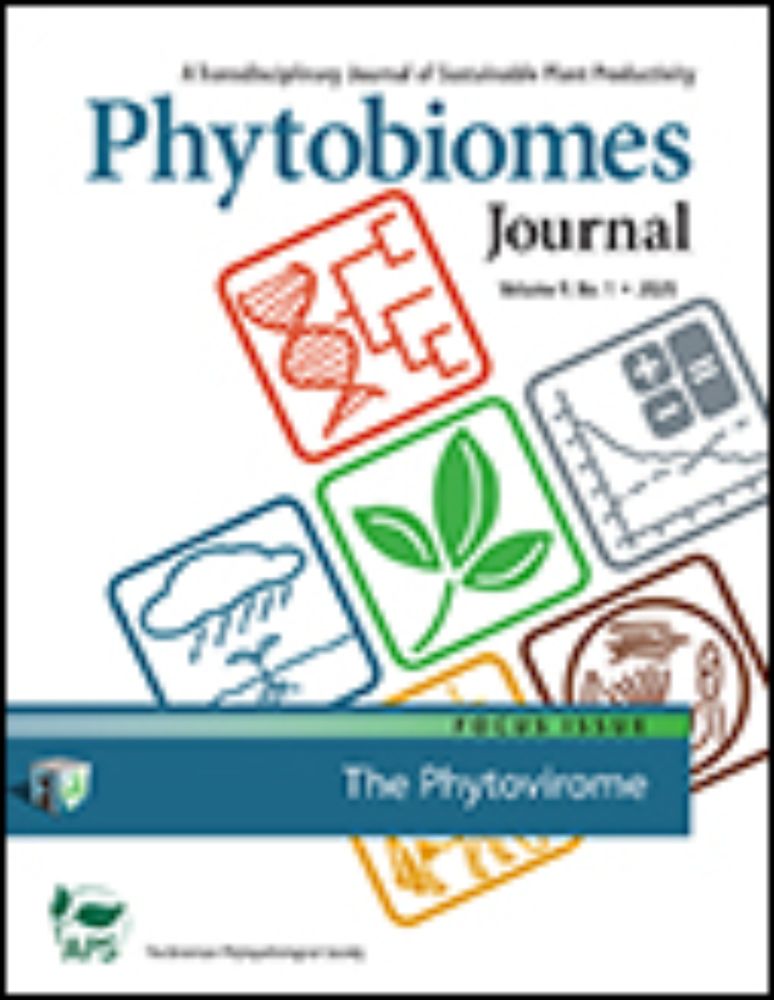
The Phytovirome | Phytobiomes Journal
The Phytovirome | Phytobiomes Journal apsjournals.apsnet.org/doi/full/10..... Schönegger et al. (2025) found that wild carrots harbored a greater diversity of virus taxa relative to farmed carrots and documented key differences in the virus communities of each host type.
03.04.2025 21:43 — 👍 3 🔁 3 💬 1 📌 0
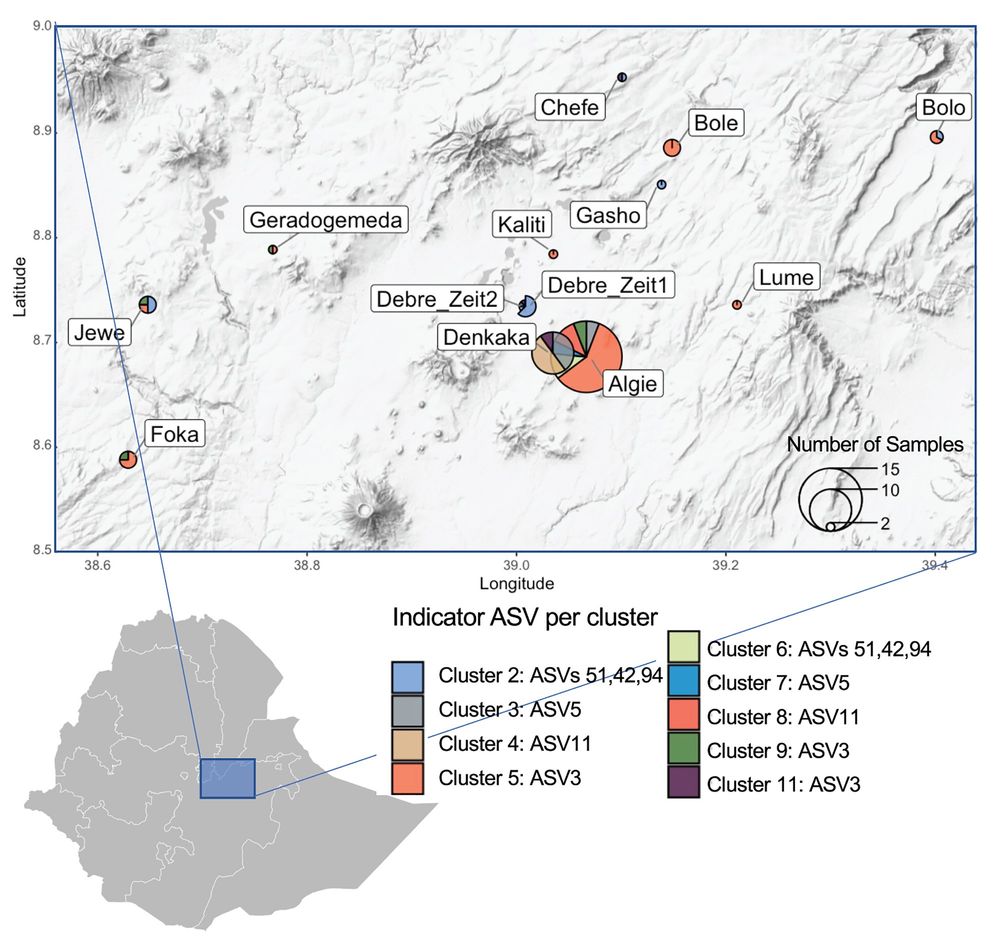
Geographic distribution and relative abundance of Silhouette clusters among symptomatic plants. Sampling depth at each site is indicated by the size of the circle. Indicator amplicon sequence variants (ASVs) are listed for each Silhouette cluster according to Figure 3 and Supplementary Table S7.
Classical approaches to plant disease diagnosis assume one pathogen per disease. Betsy A. Alford et al. reexamine Fusarium oxysporum’s presumed role in chickpea wilt/yellowing on Ethiopian smallholder farms. Learn more: doi.org/10.1094/PBIO...
21.03.2025 18:02 — 👍 1 🔁 0 💬 0 📌 0
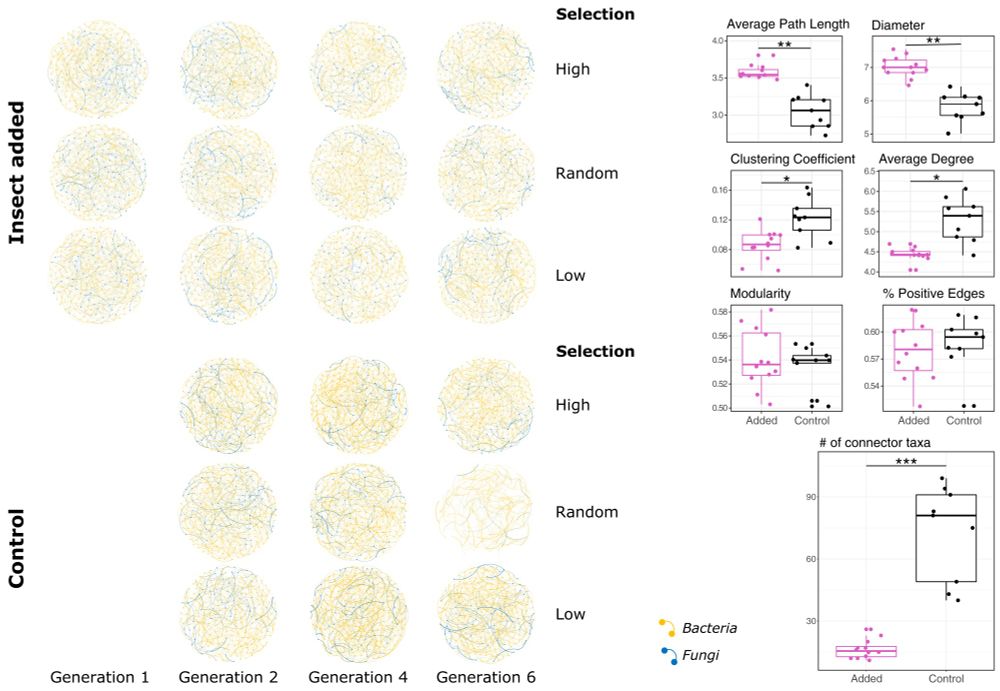
Comparison of microbial co-occurrence and network attributes associated with rhizospheres of infested versus uninfested plants across selection regimes and generations. Network attributes (e.g., average degree, modularity, # connector taxa, etc.) of each of the 21 networks, separated by insect treatment, are shown on the right. Bonferroni-adjusted results of six t tests comparing network attributes between aphid-infested and uninfested groups are inset within each top right panel (*P < 0.05, **P < 0.01), and the results of a generalized linear model of the number of connector taxa between insect treatments are presented in the bottom right panel (***P < 0.001).
Microbial communities support plant health but engineering them for pest resistance is complex. Using host-guided selection, Laramy Enders et al. reduced aphid damage on tomatoes by up to 20%, revealing key insights. Learn more: doi.org/10.1094/PBIO...
25.02.2025 17:29 — 👍 1 🔁 0 💬 0 📌 0
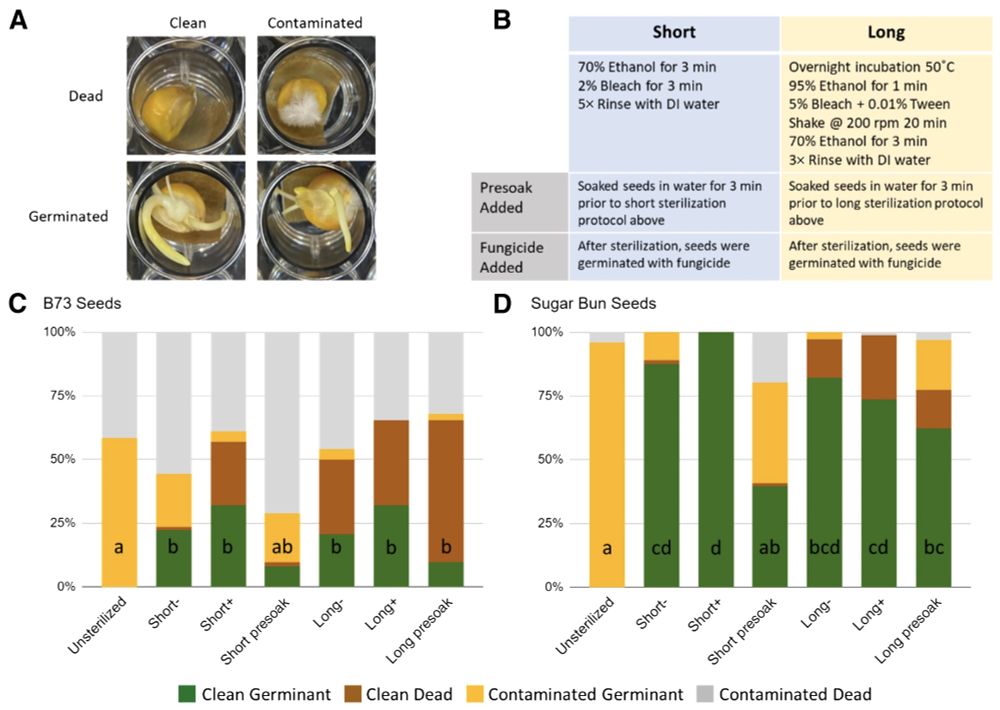
Six seed sterilization protocols tested on two varieties of maize. A, Examples of clean dead (top left), contaminated dead (top right), contaminated germinant (bottom left), and clean germinant (bottom right) B73 seeds. B, Overview of the six sterilization protocols used. Percentage of seeds that germinated and/or were contaminated with fungal growth for C, B73 seeds and D, Sugar Bun seeds for each of the different protocol variations. Letters indicate significant differences for clean germinants (Tukey honestly significant difference, P value < 0.05).
SynCom studies need seed sterilization to ensure gnotobiotic conditions. J. Jacob Parnell et al. tested six protocols on two maize varieties, finding sterilization requirements depend on genotype and seed source. doi.org/10.1094/PBIO...
11.02.2025 18:10 — 👍 0 🔁 1 💬 0 📌 0
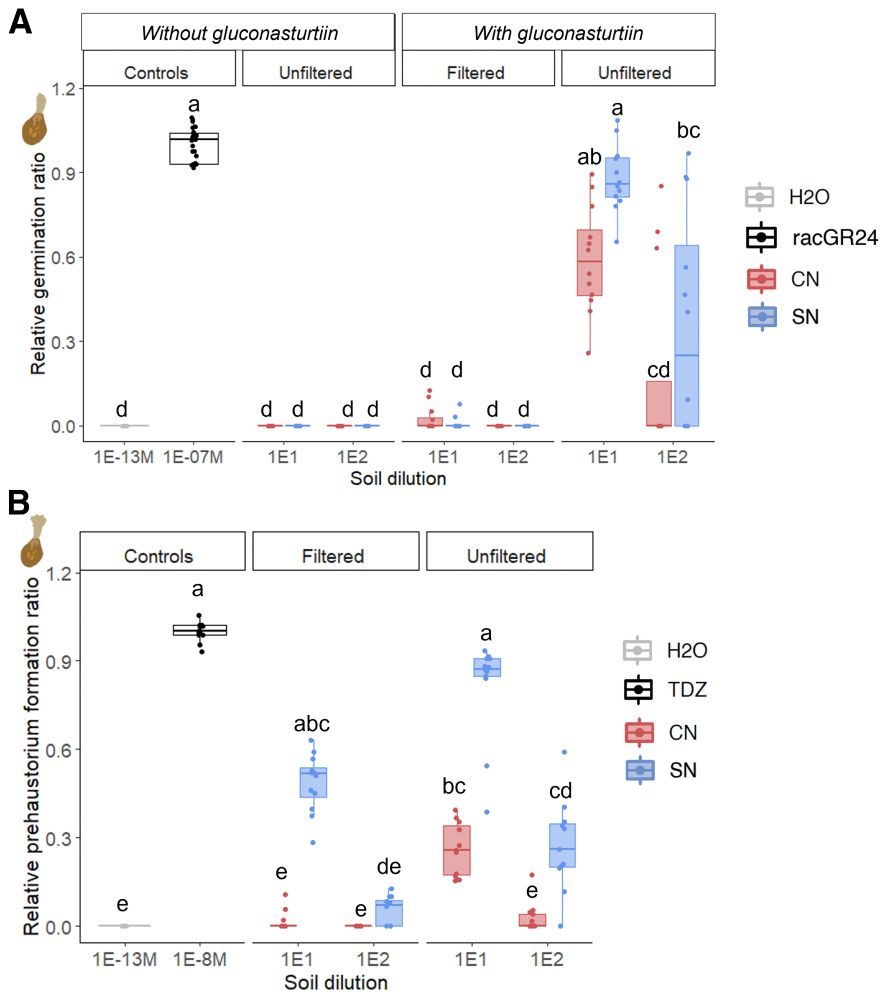
Influence of soil extracts on the stimulatory effect on broomrape seeds. A, Relative germination ratios of broomrape seeds in presence of the conducive (CN) or suppressive (SN) soil extracts, either unfiltered or 0.22-µm-filtered at 101- or 102-fold dilutions, and in the presence, or not, of gluconasturtiin (10−6 M). Ratios are expressed as the number of germinated seeds on total seeds relative to the average ratio obtained with the positive control rac-GR24 (10−7 M), a synthetic strigolactone giving a positive germination ratio of 1 ≈ 65.20 ± 6.32% (median ± sd). B, Relative prehaustorium formation ratio of broomrape seeds in presence of the CN or SN soil extracts either 0.22-µm-filtered or unfiltered and at 101 or 102 dilutions. Ratios are expressed as the number of germinated seeds presenting prehaustoria on total germinated seeds relative to the average ratio obtained with the positive control TDZ (10−8 M), a synthetic analog of cytokinin, giving a positive prehaustorium formation ratio of 1 ≈ 95.33 ± 5.33% (median ± sd). Significance was determined using a nonparametric Kruskal-Wallis rank test and Dunn's Kruskal-Wallis multiple comparisons (P ≤ 0.05) and is indicated with different letters.
In Western France, rapeseed fields with reduced Phelipanche ramosa parasitism showed fungal-driven suppression. Suppressive soils hinder attachment and induce necrosis, with Berkeleyomyces linked to the effect. Lisa Martinez et al. highlight potential control strategies. doi.org/10.1094/PBIO...
07.01.2025 19:39 — 👍 0 🔁 1 💬 0 📌 0




















